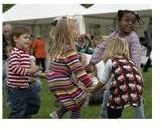Dance and ESL Lessons: Use Kinesthetic Learning To Enthuse Your Students
Eliciting Students’ Enthusiasm
Of all the different methods of learning one can employ when teaching English as a second language (ESL), kinesthetic learning is by the far the most enjoyable and practical. This very physical form of learning, whereby the student actually acts out or actively participates in the task, can prove very fruitful indeed when learning English. Many students – particularly those under the age of thirteen – respond very well to ESL lessons, which incorporate dancing into the subject matter. It’s, fun, educational and very effective.
The Importance of Kinesthetic Learning
In this lesson plan, we’re going to focus on teaching vocabulary through the medium of dance. Dancing stimulates the brain and releases pleasure hormones called endorphins, which enables the subject matter of the lesson to really ‘sink in.’
First of all, select three or four pieces of English-language music which you think would be suitable for the age group you are teaching. Also, make certain that the lyrics to the dance songs are audible, as many contemporary artists have a somewhat garbled form of delivery, which could be even more difficult for a non-native speaker to understand.
Funky Tunes and Useful Vocabulary
Once you’ve picked out a few suitable pieces, print off the lyrics from the Internet. These can be employed as handouts for the students before the dancing begins.
Take a little time to go through the lyrics with your students and make sure that they are familiar with all the vocabulary. This can sometimes prove to be time consuming if the song in question is too complex or filled with unfamiliar words. For this reason, it’s probably best to stick to relatively simple and uncomplicated song lyrics. Club music would be perfect for this kind of dance-related ESL lesson, as the lyrics are simple and your students may well already be familiar with it. However, it is essential to pick tracks across several different genres – some pop music, some rock music, and perhaps some R&B. The reason for this will become clear later on.
Let the Dancing Begin
Now it’s time for the fun part. Explain to your students that the lesson is going to be something of a dance challenge; they must act out or mime the lyrics of the song using actions, facial expressions or even props. The catch is that you’re going to be changing the tracks from one to the other every now and again. Each time this happens, students will have to adapt their mimes so that they correspond with the lyrics of the song. Finally, as a purely ‘fun’ element to the lesson, arrange a dance-off between two students voted as the best dancers.
Following this, gather the group and consolidate their knowledge of the vocabulary and perhaps cultural information they have gained through the exercise. Invite the students to summarize the plots or meaning of the lyrics of each song. Do they think the music provides an effective backing to the lyrics themselves? Get them to explain (in English if possible) the differences between each song – sad or angry, for example, and to decide which one is their favorite.
This component of the lesson allows them actively to make use of the vocabulary in the lyrics, which should already have been cemented in their minds thanks to the kinesthetic dancing exercise.
Consolidation of Knowledge And Summary
Using dance in ESL lessons can be a fun and effective way to enthuse students of any age as well as consolidate concepts of important vocabulary. In addition to this, the incorporation of English language music will also broaden their cultural awareness of the English-speaking world. They may hear the songs in nightclubs or bars, but now they will be aware of its context.
Photo Credit: WikiCommons
